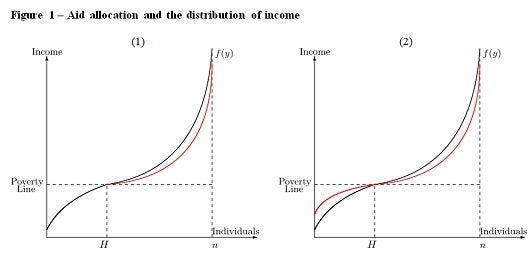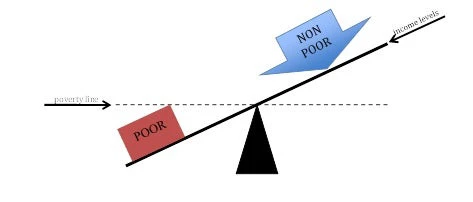Donor countries are routinely confronted with the problem of how to allocate the aid budget. The debate on aid allocation has called for various types of indicators including institutional capacities and governance but in the practice of aid allocation a multitude of factors, such as strategic geopolitical interests, budget constraints and internal political considerations, still play an important role in most countries. However, if we focus on welfare indicators and on current practices of aid allocation, there are two monetary indicators that have gained prominence over the last few decades: GDP per capita and the poverty rate. GDP per capita is a natural choice of an indicator that is well understood and widely available. The poverty rate is a more recent choice explained by the new status that poverty acquired as a development objective. For a combination of events such as the fall of the Berlin wall in 1989, the publication of the World Development Report on poverty in 1990 and the establishment of the Millennium Development Goals in 2000, multilateral organizations have increasingly adopted poverty reduction as the overarching development goal. This new focus on poverty and the increased availability of expenditure surveys worldwide have also enabled the use of poverty measures to rank countries and allocate aid.
Both GDP per capita and the poverty rate are two powerful instruments to describe the welfare of countries. GDP per capita has the advantage of being simple, transparent, and available for virtually all countries in the world while the poverty rate provides a simple measure of poverty and is now available for almost all developing nations. The question we want to address here is whether these two indicators are sufficient to allocate aid according to income criteria. GDP per capita ignores the distribution of income and is not always a good measure of household income. At times, GDP per capita and household income per capita can significantly diverge, especially in resource rich countries. The poverty rate, on the other hand, provides a focus on the poor but ignores incomes of the non-poor.
As a simple example, consider two countries, country Red and country Black, and two different scenarios, scenario (1) and scenario (2) as depicted in Figure 1. In scenario (1), the two countries have identical income distributions below the poverty line which results in identical poverty rates (as well as identical poverty gaps and severity of poverty) but very different income distributions above the poverty line. In this case, the poverty rate would not be able to rank these two countries while GDP per capita would be able to rank country Black above country Red in terms of income needs. In scenario (2), the two countries have different income distributions below and above the poverty line (the two distributions cross at the poverty line) but identical GDP per capita. In this case, GDP per capita would not be able to rank these two countries while the poverty rate would be able to rank country Black above Red. In essence, with scenarios (1) and (2), one would need two different measures to rank countries Red and Black. Can a single measure consider both the income distribution of the poor and the income distribution of the non-poor and be able to rank countries Red and Black in any of the two scenarios considered? 
This is the question addressed by a recent paper where the authors suggest considering the relation between the income of the poor and the income of the non-poor as a complement to other measures used to rank countries for the purpose of aid allocation, a concept called the “Income Lever”. The idea is simple. By constructing indexes that take into consideration the relative size of the incomes of the poor to incomes of the non-poor, it is possible to measure the income capacity of a country to reduce its own poverty and it is possible to rank the two countries shown in Figure 1 under any scenario.
Such approach relies on a simple social norm. If country A has more taxable income than country B, then country B should receive more aid than country A, everything else being equal. Of course, other considerations are important, such as the institutional capacity of a country to reduce poverty. But if we focus on income criteria only, then it should be important to know the capacity of a country to reduce its own poverty – the income lever. The analogy with physics comes to mind if we think of the poverty line as the fulcrum where the income lever lays, incomes as the distances from the fulcrum and the sum of incomes of the poor and of the non-poor as the total forces applied to the two sides of the lever.
Figure 2 – The income lever
The income lever can complement existing measures and help rich and poor countries alike. Rich countries can use the income lever to defend the legitimacy of aid and maintain aid flows. In a world where rich countries are increasingly budget constrained, better and more refined criteria for aid allocation become more important for governments in rich countries to justify the aid budget. Measures of the income lever can also help poor countries to make a better use of existing income resources. It is well known that poor and emerging economies struggle to increase the tax base with the consequence that a large portion of the taxable income is lost to informality or illegality. The income lever can provide a measure of the potential tax base that poor countries could use to improve on poverty and on the distribution of incomes. Income lever indexes could provide both rich and poor countries with relevant information to improve on the distribution of aid and on the distribution of incomes.



Join the Conversation